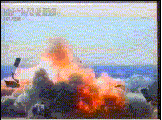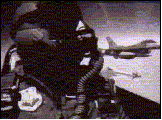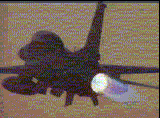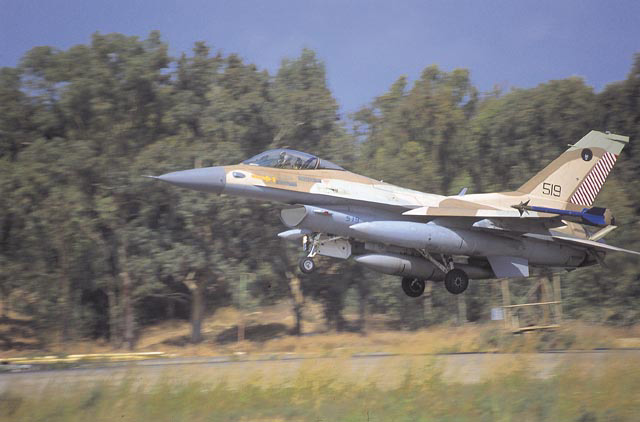|
|
|
The F-16 Fighting Falcon has evolved to incorporate sophisticated systems for night, under-the-weather and all-weather operations. A true 4th generation aircraft, the F-16, with its timeless design and incorporation of the latest technology, will retain its edge in the skies as long as it is operational. This multirole, multimission fighter provides high-performance capabilities to the air forces of 19 countries. Its success throughout the world is confirmed by follow-on buys from 13 of those countries.
This multirole, multimission fighter provides high-performance capabilities to the air forces of 19 countries. The Fighting Falcons rolling out of the factory today are not the Fighting Falcons that rolled out of the factory twenty years ago. Some differences are visible - larger horizontal tails, a wider inlet, a larger head-up display, square landing lights, tinted canopies, a thicker root and cap on the vertical tail, and various antennas, vents, bumps, and blisters.
See example for an f-16 going vertical
The F-16 Fighting Falcon is a compact, multirole fighter aircraft. It is highly maneuverable and has proven itself in air-to-air combat and air-to-surface attack. It provides a relatively low-cost, high-performance weapon system for the air forces of the United States and allied nations.
 The impacts of an f-16.
The impacts of an f-16.
In an air combat role, the F-16's maneuverability and combat radius (distance it can fly to enter air combat, stay, fight and return) exceed that of all potential threat fighter aircraft. It can locate targets in all weather conditions and detect low flying aircraft in radar ground clutter. In an air-to-surface role, the F-16 can fly more than 500 miles (860 kilometers), deliver its weapons with superior accuracy, defend itself against enemy aircraft, and return to its starting point. See example for bombing.

The cockpit and its bubble canopy give the pilot unobstructed forward and upward vision, and greatly improved vision over the side and to the rear. The seat-back angle was expanded from the usual 13 degrees to 30 degrees, increasing pilot comfort and gravity force tolerance. The pilot has excellent flight control of the F-16 through its "fly-by-wire" system. Electrical wires relay commands, replacing the usual cables and linkage controls. For easy and accurate control of the aircraft during high G-force combat maneuvers, a side stick controller is used instead of the conventional center-mounted stick. Hand pressure on the side stick controller sends electrical signals to actuators of flight control surfaces such as ailerons and rudder.
See example for bubled shape cockpit.
See example 2. for bubled shape cockpit.
The F-16A, a single-seat model, first flew in December 1976. The first operational
F-16A was delivered in January 1979 to the 388th Tactical Fighter Wing at Hill Air
Force Base, Utah.
See example for single seater.
The F-16B, a two-seat model, has tandem cockpits that are about the same size as
the one in the A model. Its bubble canopy extends to cover the second cockpit. To
make room for the second cockpit, the forward fuselage fuel tank and avionics
growth space were reduced. During training, the forward cockpit is used by a student
pilot with an instructor pilot in the rear cockpit.
see example for double seater.
Avionics systems include a highly accurate inertial navigation system in which a computer provides steering information to the pilot. The plane has UHF and VHF radios plus an instrument landing system. It also has a warning system and modular countermeasure pods to be used against airborne or surface electronic threats. The fuselage has space for additional avionics systems.
USAF F-16 multi-mission fighters were deployed to the Persian Gulf in 1991 in support of Operation Desert Storm, where more sorties were flown than with any other aircraft. These fighters were used to attack airfields, military production facilities, Scud missiles sites and a variety of other targets.
The F-16 Falcon produced by General Dynamics was originally designed as a nimble, lightweight air superiority fighter aircraft. However, this capable aircraft has been continuously upgraded and now performs a dual role as a fighter/bomber for the USAF.
The F-16 is capable of achieving a maximun speed of Mach 1.21 at sea level and Mach 2.05 at altitude. Its service ceiling is approximately 61,000 feet and it is capable of an amazing initial climb rate exceeding 50,000 feet per minute! The Falcon is armed with a M61A-1 20 mm cannon, and is capable of carrying a variety of armament including AIM-9, AIM-7, and AIM-120 air-to-air missiles, as well as a varitey of air-to-ground bombs and missiles. This has made the Falcon a very versatile weapon in the USAF's inventory.

The General Dynamics F-16 Fighting Falcon is one of most significant fighters of the latter part of the 20th century. It was originally developed from a concept for an experimental lightweight fighter and has evolved into an all-weather fighter and precision attack aircraft. The F-16 has been manufactured on as many as five separate production lines, making it the largest fighter program in the Western world. Over 4000 F-16s have been built, with production still continuing.
Mission- The F-16 Fighting Falcon is a compact, multirole fighter aircraft. It is highly maneuverable and has proven itself in air-to-air combat and air-to-surface attack. It provides a relatively low-cost, high-performance weapon system for the United States and allied nations.
Current contacts are being performed by GLOBAL AEROSPACE INDUSTRIES for F-16 Aircraft support in these countries:
*THE
NETHERLANDS
*INDONESIIA
*BAHRAIN
*UNITED STATES
*BELGIUM
*DENMARK
*EGYPT
*TURKEY
*THAILAND
*SINGAPORE
*NORWAY
*VINEZUELA
*ISRAEL
*GREECE
*KOREA
Congratulations you are a pilot!!
